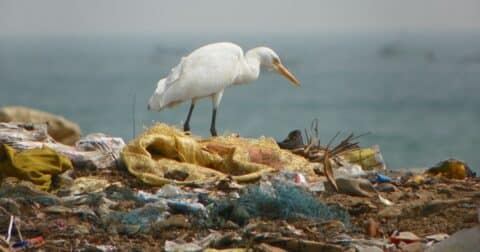News
COP30 Has Big Plans to Save the Rainforest. Indigenous Activists Say It’s Not Enough.
Climate•6 min read
Explainer
You might have heard the claim humans are “destroying” the planet — but how do you actually measure that?


Words by Seth Millstein
The Earth’s many ecosystems form the foundation for life on this planet, providing us with clean air, drinkable water and fertile soil. But human activities have drastically altered these vital systems, and that damage has accelerated over time. The consequences of ecosystem destruction are far-reaching and dire, and threaten to destabilize the natural environmental processes that we rely on to live.
A United Nations report found that three-quarters of land-based environments, and two-thirds of marine-based environments, have been detrimentally altered by human activities. In order to reduce habitat loss and slow down extinction rates, we need to understand how human activities threaten and endanger the planet’s ecosystems.
An ecosystem is the interconnected system of plants, animals, microorganisms and environmental elements that occupy a given space. The interactions of all these flora and fauna are what enables the ecosystem to perpetuate; removing or altering a single element can throw the entire system out of whack, and in the long run, threaten its continued existence.
An ecosystem can be as small as a puddle of water or as big as a planet, and many ecosystems contain other ecosystems within them. For instance, ocean surface ecosystems exist within the larger ecosystems of oceans themselves. The Earth’s ecosystem is itself the culmination of countless sub-ecosystems interacting with one another around the world.
Many common human activities damage, altar or destroy the Earth’s ecosystems. Agricultural expansion, extraction of natural resources and urbanization are the sort of large-scale initiatives that contribute to ecosystemic destruction, while individual actions like overhunting and the introduction of invasive species can also contribute to an ecosystem’s decline.
These activities, to varying degrees, pollute the air and water, degrade and erode the soil, and cause the death of animals and plants. They also disrupt the natural environmental processes that allow ecosystems to exist, such as the hydrologic cycle. As a result, these ecosystems are degraded and, in some cases, destroyed entirely.
A good illustration of how all this works is deforestation, which is when a forested area is permanently cleared and repurposed for another use. Around 90 percent of deforestation is driven by agricultural expansion;cattle farms are the most common type of agricultural expansion in deforested areas, so let’s use a cattle farm as our case study.
When the forest is initially cleared, a few things happen. First, the very act of cutting down the trees releases massive amounts of carbon dioxide, a major greenhouse gas, into the atmosphere, and erodes the soil from which the trees grew. The absence of trees and canopy also means the death of local animal populations who rely on the forest for food and shelter.
Once the land has been converted into a cattle farm, the destruction continues. The farm will continuously pollute the air, because animal agriculture emits enormous amounts of greenhouse gasses. The farm will also pollute nearby water, as nutrient runoff and animal waste makes its way into nearby waterways.
Finally, because the trees that had previously been trapping and sequestering carbon dioxide from the atmosphere are now gone, air pollution in the region will be worse in the long-term, and that will remain the case even if the farm is shuttered.
Because ecosystems are extraordinarily complex and varied entities, there’s no single way to assess their health or, conversely, how much damage they’ve sustained. There are several perspectives from which to look at ecosystemic destruction, and they all point to the same conclusion: humans are wreaking havoc on the Earth’s ecosystems.
One way to see how humans are damaging ecosystems is to look at the alteration and pollution of our planet’s land and water. Scientists have found that less than three percent of the Earth’s total land is still ecologically intact, meaning that it has the same flora and fauna that it did in pre-industrial times. In 2020, a report from the World Wildlife Foundation found that humans are overusing the Earth’s biologically productive land, such as cropland, fisheries and forests, by at least 56 percent. At least 75 percent of the Earth’s ice-free land has been significantly altered by human activity as well, that same report found. In the last 10,000 years, humans have destroyed around one-third of all forests on Earth. What makes this especially alarming is that around three-quarters of that destruction, or 1.5 billion hectares of land loss, occurred within the last 300 years alone. According to the United Nations, humanity is currently destroying an average of 10 million hectares of forest every year.
According to a 2020 study published in One Earth, 1.9 million km2 of previously undisturbed terrestrial ecosystems — an area the size of Mexico — were highly modified by human activity between 2000 and 2013 alone. The most heavily impacted ecosystems in this 13-year period were tropical grasslands and forests in Southeast Asia. In totality, the report found, almost 60 percent of Earth’s land ecosystems are under severe or moderate pressure from human activity.
The planet’s aquatic ecosystems aren’t faring much better. The EPA uses the concept of “impairment” to measure water pollution; a waterway counts as impaired if it’s too polluted to swim in or drink, the fish in it are unsafe to eat due to pollution, or it’s so polluted that its aquatic life is threatened. A 2022 analysis by the Environmental Integrity Project found that on a per-acre basis, 55 percent of lakes, ponds and reservoirs on the planet are impaired, along with 51 percent of rivers, streams and creeks.
The world’s coral reefs are extremely important ecosystems as well. They’re home to about 25 percent of the ocean’s fish and a wide range of other species — and unfortunately, they’ve been seriously degraded, too.
The U.N. Environment Programme (UNEP) found that between 2009 and 2018, the world lost about 11,700 square kilometers of coral, or 14 percent of the global total. More than 30 percent of the world’s reefs have been affected by rising temperatures, and UNEP projects that by 2050, there will be a 70-90 percent worldwide decrease in live coral reefs due to climate change. The report even raised the possibility that coral reefs may become extinct within our lifetimes.
Finally, we can measure the extent of our ecosystem destruction by looking at biodiversity loss. This refers to the reduction of plant and animal populations, as well as the extinction and near-extinction of species around the world.
The WWF report mentioned earlier found that between 1970 and 2016, populations of mammals, birds, amphibians, reptiles and fish around the world have declined by an average of 68 percent. In the tropical subregions of South America, they fell by a staggering 94 percent.
The data on extinctions is even grimmer. Every day, an estimated 137 species of plants, animals and insects go extinct due to deforestation alone, and it’s estimated that another three million species that live in the Amazon rainforest are threatened by deforestation. The International Union for Conservation of Nature lists 45,321 species around the world that are critically endangered, endangered or vulnerable. According to a 2019 analysis, over one-third of marine mammals are now threatened with extinction.
Even more concerning is the fact that, according to a 2023 Stanford study, entire genuses are now going extinct at a rate 35 times higher than the historical average. This pace of extinction, the authors wrote, represents an “irreversible threat to the persistence of civilization,” and is “destroying the conditions that make human life possible.”
The world’s interlocking ecosystems are why life on Earth is possible. Trees sequester carbon dioxide and release oxygen, making the air breathable; soil traps water, providing protection against floods and allowing us to grow food to feed us; forests provide us with life-saving medicinal plants, and help maintain a high level of biodiversity, while clean waterways ensure that we have enough water to drink.
But all of this is precarious. Humans are slowly but surely destroying the ecosystems that we rely on. If we don’t reverse course soon, the damage may eventually make the planet inhospitable to our own species — and many others.